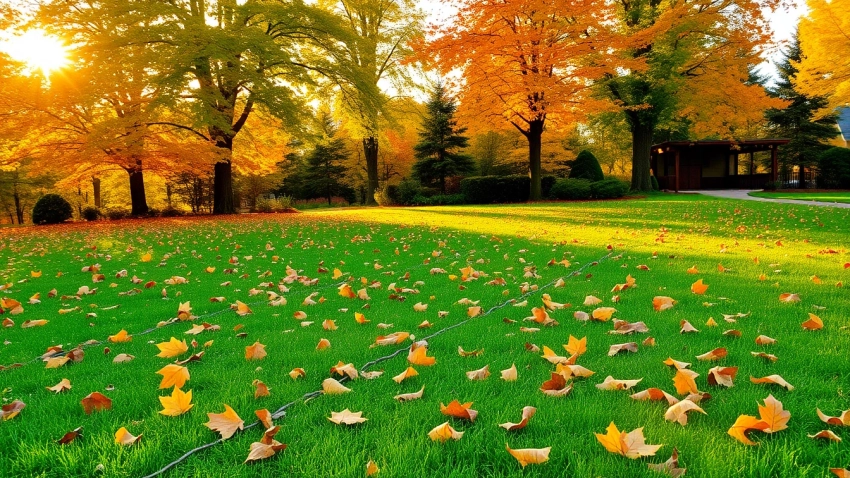
Essential Fall Clean Up Strategies to Maintain Your Lawn’s Health
Understanding the Importance of Fall Clean Up
As summer’s warmth gradually fades, preparing your lawn for the impending winter becomes paramount. A comprehensive fall clean up serves not only to enhance the appearance of your outdoor space but also to promote the long-term health and sustainability of your lawn. Seasonal clean-up efforts are vital in preventing pests, diseases, and fostering a thriving landscape ready to weather the colder months ahead.
Why Fall Clean Up Matters for Lawn Health
When fall arrives, leaves change color and start to fall, covering your lawn in a vibrant yet troublesome layer of organic matter. While beautiful, this accumulation can create a thriving environment for pests and diseases, ultimately leading to neglected lawn health. Implementing proper fall clean-up practices can safeguard your lawn against:
- Fungal Diseases: Leaves left on the ground trap moisture, creating a breeding ground for molds and decay.
- Pest Infestations: Insects often seek shelter under mulch or fallen debris, leading to increased populations come spring.
- Thatch Buildup: A thick layer of decomposing matter can prevent air, water, and nutrients from reaching your grass roots.
Common Debris and Its Impact
During fall, lawns accumulate various types of debris, including:
- Leaves: The most common issue, leaves can smother grass if not removed.
- Weeds: Depending on your region’s climate, certain weeds may attempt to grow in fall.
- Branches and Twigs: Larger debris can obstruct mowing and prevent grass from getting adequate sunlight.
All of these debris types can negatively impact lawn health, making it essential to address them through diligent clean-up efforts.
Environmental Benefits of Proper Clean Up
Beyond enhancing your lawn’s aesthetics and health, fall clean-up offers genuine environmental perks, including:
- Organic Recycling: Leaving leaves on your lawn can seem ecologically sound. However, composting them instead prevents excess moisture buildup.
- Biodiversity Support: A well-maintained lawn encourages beneficial insects and small wildlife to thrive.
- Soil Health Improvement: Regular clean-up prevents the proliferation of pests and diseases that can alter soil health.
Key Steps in Your Fall Clean Up Process
Effective fall clean-up requires a thoughtful approach, beginning with an assessment of your lawn’s current state and moving through several actionable steps.
Preparing Your Lawn for Winter
The fall clean-up process starts with inspection. You’ll need to evaluate your lawn’s condition by checking for:
- Color Changes: Dull patches may indicate a need for soil aeration or fertilization.
- Thatch Issues: Look for an accumulation of organic debris that may require power raking or dethatching techniques.
- Weed Presence: Identify troublesome areas to address before winter.
After taking stock, it’s time to prepare the lawn for winter. This means scoring the turf to aerate and allow nutrients to enter the soil. It’s also an opportune moment to overseed if necessary.
Effective Leaf and Debris Removal Techniques
Gathering leaves can be labor-intensive, but several techniques can streamline the process:
- Raking: A classic method. A sturdy rake will suffice for small areas or smaller leaf volumes.
- Blowing: Leaf blowers can clear large areas quickly, directing leaves away from lawn surfaces.
- Lawn Mowers: Many modern mowers come equipped with mulching blades to cut and disperse leaves back into the lawn as compost material.
Trimming and Pruning for Optimal Growth
Fall is also a prime time to prune trees, shrubs, and perennials. Proper trimming not only enhances aesthetic appeal but reduces the risk of breakage from snow and ice. Focus on:
- Removing Dead or Diseased Growth: This helps prevent diseases from spreading.
- Encouraging Healthy Growth: Trim back perennials, preparing them for a robust spring.
- Enhancing Air Flow: Well-spaced branches prevent pest infestations.
Tools and Equipment Needed for Fall Clean Up
Investing in the right tools can make your fall clean-up efforts not only more efficient but safer as well.
Hand Tools vs. Power Tools
Hand tools like rakes and pruners are essential for any clean-up, but many homeowners find power tools significantly expedite the process:
- Leaf Blower: Effective for covering large areas of lawn.
- Lawn Vacuum: Ideal for collection without raking.
- Power Rake: Great for managing thatch and uneven surfaces.
Essential Gear for Safety and Efficiency
Safety should never be overlooked. Essential gear includes:
- Gloves: Protect your hands from cuts and blisters.
- Boots: Support traction and comfort during outdoor work.
- Safety Glasses: Protect eyes from flying debris while using power tools.
Best Practices for Tool Maintenance
To ensure your tools last for many seasons, regular maintenance is critical. Best practices involve:
- Cleaning: After use, remove dirt and debris from tools.
- Sharpening: Keeping blades sharp aids efficiency.
- Storage: Store tools in a dry place to prevent corrosion.
Hiring Professionals vs. DIY: What You Should Consider
While many homeowners opt for a DIY approach, hiring professionals for fall clean-up can ensure thorough results and save significant time. Weigh your options carefully.
Cost Comparison for Fall Clean Up Services
The cost of hiring professionals varies based on location, lawn size, and the specific services required. In general, homeowners can expect:
- Basic Clean-Up: $200 – $300 for a small yard.
- Medium Yards: $300 – $500 for extensive services.
- Large Properties: $500 and up, depending on the scale of the work.
When to Call in the Experts
Consider hiring professionals in scenarios such as:
- Size of the Job: Overwhelming debris can warrant a professional service.
- Specialized Services: Complex tasks like tree trimming may require expert knowledge.
- Lack of Time: When your schedule is jam-packed, calling in experts can provide peace of mind.
Benefits of Hiring Local Services
Local services often provide unique benefits, including:
- Knowledge of Local Conditions: Local professionals understand the specific challenges presented by your area’s climate.
- Community Engagement: Supporting local businesses can foster community ties.
- Faster Response: Proximity enables quicker service and flexibility in scheduling.
Post Clean Up: Preparing for Winter
Fall clean-up is just the first step toward winterizing your lawn. Ensuring your garden and lawn are arborally ready requires continued attention.
Winterizing Your Lawn for Optimal Health
Winterizing involves several steps:
- Fertilizing: Apply a winter fertilizer to provide nutrients through colder months.
- Seeding: If overseeding was not done in fall, it’s important to apply viable seeds at this juncture.
- Mulching: Use organic material to protect the soil.
Creating a Spring Clean Up Plan
Having a plan in place for spring clean-up will ensure lower stress when warmer weather arrives:
- Schedule Tasks: Establish a timeline for mowing, planting, and any required professional services.
- Assess Former Clean-Up Outcomes: Evaluate previous efforts to inform future decisions on techniques and preferences.
- Budgeting: Prepare a financial framework for spring services to avoid last-minute surprises.
Seasonal Tips for Lawn Care Enthusiasts
For those dedicated to lawn care, maintain engagement with seasonal techniques such as:
- Winter Interest Plants: Incorporate plants that maintain structure and color throughout winter.
- Snow Management: Manage snowfall effectively to prevent compaction on your lawn.
- Continuous Learning: Stay updated with lawn care best practices, and consider taking classes or online tutorials for deepening knowledge.












Leave a Reply